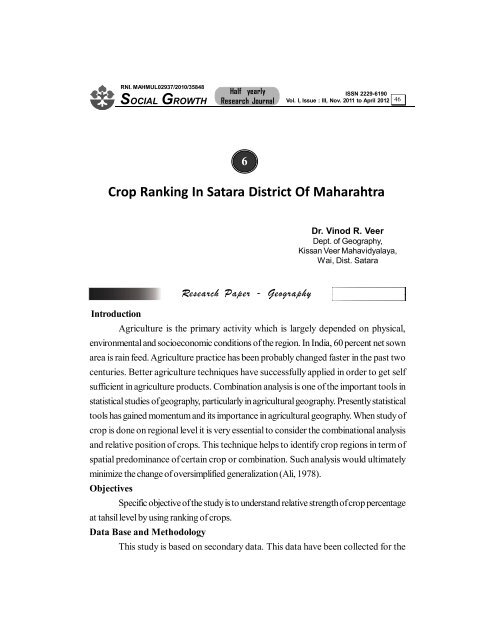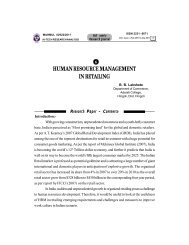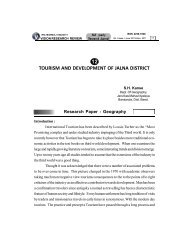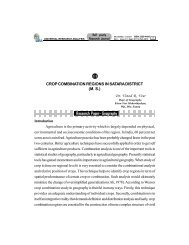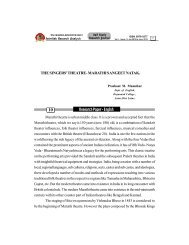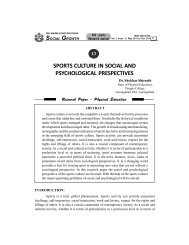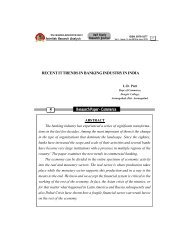You also want an ePaper? Increase the reach of your titles
YUMPU automatically turns print PDFs into web optimized ePapers that Google loves.
Introduction<br />
RNI. MAHMUL02937/2010/35848<br />
SOCIAL GROWTH<br />
Half yearly<br />
Research Journal<br />
ISSN 2229-6190<br />
Vol. I, Issue : III, Nov. 2011 to April 2012<br />
Agriculture is the primary activity which is largely depended on physical,<br />
environmental and socioeconomic conditions of the region. In India, 60 percent net sown<br />
area is rain feed. Agriculture practice has been probably changed faster in the past two<br />
centuries. Better agriculture techniques have successfully applied in order to get self<br />
sufficient in agriculture products. Combination analysis is one of the important tools in<br />
statistical studies of geography, particularly in agricultural geography. Presently statistical<br />
tools has gained momentum and its importance in agricultural geography. When study of<br />
crop is done on regional level it is very essential to consider the combinational analysis<br />
and relative position of crops. This technique helps to identify crop regions in term of<br />
spatial predominance of certain crop or combination. Such analysis would ultimately<br />
minimize the change of oversimplified generalization (Ali, 1978).<br />
Objectives<br />
Specific objective of the study is to understand relative strength of crop percentage<br />
at tahsil level by using ranking of crops.<br />
Data Base and Methodology<br />
6<br />
Crop Ranking In Satara District Of Maharahtra<br />
Research Paper - Geography<br />
Dr. Vinod R. Veer<br />
Dept. of Geography,<br />
Kissan Veer Mahavidyalaya,<br />
Wai, Dist. Satara<br />
This study is based on secondary data. This data have been collected for the<br />
46
RNI. MAHMUL02937/2010/35848<br />
SOCIAL GROWTH<br />
Half yearly<br />
Research Journal<br />
ISSN 2229-6190<br />
Vol. I, Issue : III, Nov. 2011 to April 2012<br />
year 2005-2006 for ten crops in eleven tahsils from Revenue Department, Agriculture<br />
Department and Land Record Office, Satara. This data were converted into percentage.<br />
In order to compute crop ranking ten dominant crops have taken into consideration.<br />
These crops are, namely, jowar, bajra, rice, sugarcane, fodder crops, groundnut, fruits<br />
and vegetables, wheat, kidneybean and gram.<br />
Study Area<br />
Satara district lies in west part in Maharashtra state. It extends from 17º 5´ to 18º<br />
11´ north latitudes and from 73º 33´ to 74º 54´ east longitudes on 10,484.00 square<br />
kilometers area. In term of area, Satara district ranks fifteenth in Maharashtra state. This<br />
district has 2,808,994 persons (2001 Censes). Satara district is bounded by Pune district<br />
in north, Solapur district in east, Sangali district in south, Ratnagiri district in west and<br />
Raigad district in northwest. According to 2001 Census, Satara district consists of eleven<br />
tahasils having 1573 villages. These eleven tahsils are, namely, Satara, Wai, Khandala,<br />
Koregaon, Phaltan, Man (Dahiwadi), Khatav (Vaduj), Karad, Patan, Jaoli (Medha) and<br />
Mahabaleshwar. The Satara district varies in relief, climate and vegetation.<br />
Discussion and Results<br />
First Ranking<br />
Jowar, fodder crop, bajra, sugarcane and rice have identified as first ranking<br />
crops in Satara district. Jowar is identified as first ranking crops in five tahsils occupying<br />
43.05 percent of total area of first rank crop in study area. Jowar belt is concentrated in<br />
north and central parts. Fodder crop as second crop has identified in first ranking crop.<br />
It is concentrated on east and west part in study region on 29.77 percent as first rank<br />
crop. Bajra, rice and sugarcane crops have identified as first rank in study region. Bajra<br />
shows first rank in Khatav tahsil while rice and sugarcane occupies first rank in Patan and<br />
Karad tahsils respectively. Bajra as a first ranking is practiced on 22309 hectares (11.38<br />
percent). While sugarcane is practiced on 19497 hectares (9.94 percent) and rice is<br />
practiced on 11494 hectares (5.86 percent) in study region. Sugarcane appears on<br />
southern part in study region on deep soil along Krishna river. Rice appears on southwest<br />
part in Satara district where rainfall is high and soil is red in colour. Bajra ranks first in<br />
Khatav tahsil laying in southeast parts having less rainfall region and has coarse shallow<br />
47
soil.<br />
RNI. MAHMUL02937/2010/35848<br />
SOCIAL GROWTH<br />
Sr.No. Crops<br />
Second Ranking<br />
Half yearly<br />
Research Journal<br />
Table-1 : Crop Rank Frequency<br />
ISSN 2229-6190<br />
Vol. I, Issue : III, Nov. 2011 to April 2012<br />
Crop Ranks and Number of Tahsils<br />
1 2 3 4 5 6 7 8 9 10<br />
1 Jowar 5 3 1 1 1 0 0 0 0 0<br />
2 Fodder crop 3 2 3 1 0 0 1 0 1 0<br />
3 Bajra 1 4 0 1 0 0 0 0 2 2<br />
4 Rice 1 0 2 0 3 2 0 0 2 0<br />
5 Sugarcane 1 0 1 2 3 0 3 0 0 0<br />
6 Groundnut 0 1 2 2 1 0 0 3 0 1<br />
7 Fruits and Vegetables 0 1 2 0 1 3 0 3 1 0<br />
8 Wheat 0 0 0 3 2 3 2 1 0 0<br />
9 Kidneybean 0 0 0 1 0 1 0 0 3 5<br />
10 Gram 0 0 0 0 0 2 4 3 1 1<br />
Source : Computed by Researcher<br />
Five crops have been identified as second ranking crops. These crops are bajra,<br />
jowar, fodder crop, groundnut and fruits and vegetables. Among these second ranking<br />
crops, bajra is cultivated in four tahsils. It is distributed in north and east parts in study<br />
area covering 65364 hectares. These tahsils are namely, Wai, Khandala, Phaltan and<br />
Man. In these tahsils, bajra is cultivated on coarse shallow soil. Jowar is identified as<br />
second ranking crop in three tahsils occupying 42142 hectares. Its distribution in study<br />
area appears into two patches. One patch is lying in west part and another is located in<br />
southeast part. In two tahsils fodder crops have been identified as second ranking crop<br />
practiced on 22818 hectares (16.34 percent) in study region. Fodder crop is identified<br />
as second ranking crop in Koregaon and Patan tahsils. Koregaon tahsil is located in<br />
central part in Satara district while Patan tahsil lies in southwest part. Groundnut, fruits<br />
and vegetables have found as second rank crop in one tahsil each on 8477 hectares and<br />
832 hectares respectively. Groundnut is identified as second ranking crop in Satara tahsil<br />
48
RNI. MAHMUL02937/2010/35848<br />
SOCIAL GROWTH<br />
Half yearly<br />
Research Journal<br />
ISSN 2229-6190<br />
Vol. I, Issue : III, Nov. 2011 to April 2012<br />
and its position is identified in central part in study area. While fruits and vegetables is<br />
identified as second ranking crop in Mahabaleshwar tahsil in study area.<br />
Third Ranking<br />
In third ranking crops number have increased than earlier ranking crops in number.<br />
These six crops are, namely, fodder crops, jowar, groundnut, rice, sugarcane and fruits<br />
and vegetables. Among these crops fodder crops is dominant crop in this ranking. It is<br />
cultivated in three tahsils on 28939 hectares. These tahsils are Satara, Phaltan and Karad.<br />
Phaltan tahsil is located in northeast part in study area while Satara tahsil is located in<br />
central part.Karad tahsil is located in south part in study region. Jowar is identified as<br />
third ranking crop in Man tahsil covering 25374 hectares. Man tahsil is located in east<br />
part in study area. Groundnut is identified as third ranking crop in Wai and Patan on<br />
13108 hectares. Rice is ranked as third in Mahabaleshwar and Jaoli tahsils covering<br />
9710 hectares area. One identical rice patch is visible in west part. In this area hilly<br />
topography is present. Sugarcane has been ranked as third crop only in Koregaon tahsils<br />
lying in central part of study area. This crop practiced on 7008 hectares area in Koregaon<br />
tahsil. Fruits and vegetables have ranked as third in two tahsils covering 6658 hectares.<br />
Two patches of fruits and vegetables have seen in study area. One patch is found in<br />
southeast and another patch in north parts in study area.<br />
Fourth Ranking<br />
The fourth ranking crops present relatively increasing number of crops than earlier<br />
ranking. Seven crops have identified in fourth ranking crop. These seven crops are,<br />
namely, sugarcane, groundnut, wheat, bajra, kidneybean, jowar and fodder crops. Among<br />
these seven crops, sugarcane is cultivated in two tahsils in study region. Groundnut is<br />
identified as fourth ranking crop in Jaoli and Karad tahsils occupying 11588 hectare<br />
areas. In three tahsils, wheat has been identified as fourth ranking (13.23 percent) in<br />
study region. These tahsils are, namely, Mahabaleshwar, Phaltan and Khatav lying west,<br />
northeast and southeast parts in study region. Bajra is ranked as fourth in Koregaon tahsil<br />
covering 5937 hectares. Here bajra is cultivated on coarse shallow soil. Kidneybean<br />
have been ranked as fourth crop in Man tahsil covering 5275 hectares. Jowar is identified<br />
as fourth ranking crop in Patan tahsil. Fodder crop has been ranked as fourth ranking in<br />
49
RNI. MAHMUL02937/2010/35848<br />
SOCIAL GROWTH<br />
Half yearly<br />
Research Journal<br />
ISSN 2229-6190<br />
Vol. I, Issue : III, Nov. 2011 to April 2012<br />
Khandala tahsil lying in north part in study area (1493 hectares).<br />
Fifth Ranking<br />
Six crops have entered in fifth ranking in Satara district (Table-5.6). These crops<br />
are, namely, rice, sugarcane, fruits and vegetables, wheat, groundnut and jowar. Rice<br />
holds rank fifth in three tahsil (27.27 percent). The distribution of rice in study area is<br />
found in one continuous patch consisting of Wai, Satara and Karad lying on foothill of<br />
western side of Sahyadri ranges. Rice covers 11334 hectares area in these tahsils.<br />
Sugarcane is found as fifth in three tahsils on 9001 hectares (30.73 percent). These<br />
tahsils are, namely, Phaltan, Khatav and Patan in study region.Fruits and vegetables stand<br />
as fifth rank in Man tahsil covering 3349 hectares (11.43 percent). Wheat ranks as fifth<br />
crop in two tahsils on 2938 hectares (10.03 percent) in Jaoli and Khandala. Groundnut<br />
ranks fifth in Koregaon tahsil lying central part in study area. Groundnut is practiced on<br />
2424 hectare area in Koregaon tahsil. Jowar is found as fifth ranking crop in<br />
Mahabaleshwar tahsil. Area under jowar in this tahsil is only 243 hectares. Due to heavy<br />
rainfall and hilly topography less cultivation of jowar practiced in Mahabaleshwar tahsil.<br />
Sixth Ranking<br />
There are five crops which emerged as sixth rank in Satara district. These crops<br />
are fruits and vegetables, wheat, rice, gram and kidneybean. Among these crops, fruits<br />
and vegetables are principle crops found higher coverage on 4079 hectares (26.39 percent)<br />
in Jaoli, Koregaon and Karad tahsils. Wheat occupies sixth ranking crop in three tahsils<br />
consisting of two patches. One patch is located in eastern part in Man tahsil. While other<br />
patch is located in central and west parts in Satara and Patan tahsils. This crop is cultivated<br />
on 3838 hectares. Rice is cultivated on 3775 hectares and it occupies sixth rank in two<br />
tahsils forming one continuous patch lying north in study area. This patch is identified in<br />
Khandala and Phaltan tahsils. Gram rank sixth position in two tahsils practiced on 3139<br />
hectars in study area. The cultivation of gram is spreaded in one patch lying in northwestern<br />
hilly part. This patch is located in Mahabaleshwar and Wai tahsils. Kidneybean has ranked<br />
as sixth in Khatav tahsil located in southeast part in study area. Area under kidneybean is<br />
634 hectares in Khatav tahsil accounting 4.10 percent under sixth ranking crop.<br />
Seventh Ranking<br />
There are four crops in this ranking. These crops are, namely, gram, fodder crop,<br />
wheat and sugarcane. Among these crops, gram stands first in study region. The distribution<br />
50
RNI. MAHMUL02937/2010/35848<br />
SOCIAL GROWTH<br />
Half yearly<br />
Research Journal<br />
ISSN 2229-6190<br />
Vol. I, Issue : III, Nov. 2011 to April 2012<br />
of gram appears in two patches. One patch lying central and southwest parts in Satara<br />
and Patan tahsils. Gram is grown on 4814 hectares in study area. Wheat ranks seventh<br />
position in two tahsils on 2580 hectares in study area. The cultivation of wheat is identified<br />
into Koregaon and Karad tahsils on deep and medium black soils. Sugarcane ranked<br />
seventh in three tahsils distributed in three patches. One patch is identified in Jaoli tahsils<br />
lying in western parts in Satara district and another patch lying north part in Khandala<br />
tahsil. Third patch lies on east part in study area consisting of Man tahsil where irrigation<br />
is available for sugarcane <strong>growth</strong>. This area is very limited. Sugarcane is found as seventh<br />
ranking crop on 1586 hectares area.<br />
Eighth Ranking<br />
Four crops have been identified as eighth ranking crops. These crops are, namely,<br />
fruits and vegetables, wheat, gram and groundnut. Fruits and vegetables ranks eight is<br />
found in three tahsils occupying 34.50 percent area in study region. Fruits and vegetables<br />
belt is concentrated in southwest, central and northeast part in study region. Wheat is<br />
another crop showing eighth rank in study region. Its cultivation is found on hilly northwest<br />
part in study area. This crop is grown on 2666 hectares occupying 28.14 percent of total<br />
area. Gram has identified as eighth ranking crop in three tahsils, namely, Jaoli, Koregaon<br />
and Karad. Jaoli lies at west part in study region, Koregaon located in central part and<br />
remaining Karad tahsil lies at south part in Satara district. Gram is grown in combination<br />
with other crops in three tahsils. Groundnut ranks eight in three tahsils, namely, Khandala,<br />
Man and Khatav. All these three tahsils experience drought prone. The cultivation of<br />
groundnut is found in two patches. One patch is located in north part and another part lies<br />
at east part in study region.<br />
Ninth Ranking<br />
In ninth ranking number of crops have increased than eight rank reveals distribution<br />
of ninth ranking crop in Satara district. These are six crops, namely, kidneybean, fruits<br />
and vegetables gram, rice, bajra and fodder crops are included in ninth ranking. Area<br />
under bajra is observed in one patch in Karad and Patan tahsils. Tenth Ranking<br />
Ten dominent crops have taken into consideration to compute crop ranking.<br />
Among these, six crops are grown in Mahabaleshwar tahsil. In Jaoli, Patan, Khatav and<br />
Man tahsils show nine crops cultivation. In Jaoli, Patan and man tahsil crops, namely,<br />
51
RNI. MAHMUL02937/2010/35848<br />
SOCIAL GROWTH<br />
Half yearly<br />
Research Journal<br />
ISSN 2229-6190<br />
Vol. I, Issue : III, Nov. 2011 to April 2012<br />
bajra, kidneybean and gram are not grown. Three crops kidneybean, bajra and groundnut<br />
have entered in tenth ranking in Satara district. Kidneybean holds rank tenth in four<br />
tahsils (63.06 percent). The distribution of kidneybean in study area is found in one<br />
patch. The patch of four tahsil is found in north, central, northwest and south parts in<br />
Koregaon, Khandala, Karad and Wai tahsils. A groundnut rank tenth is found in Phaltan<br />
tahsil on 367 hectares (36.44 percent area). Bajra stands as a tenth rank in Satara tahsil<br />
covering 5 hectares land. Conclusion<br />
Sugarcane appears as dominant crop on southern part of study region where<br />
deep soil is present along Krishna river. In the areas of high rainfall and red soil rice<br />
appears as dominant crop. These areas lie in southwest part of Satara district. Bajra<br />
ranks higher in areas of less rainfall and coarse shallow soil. Fodder crops are dominant<br />
in areas were number of domesticated animals are more. Area under fruits and vegetables<br />
is more in hilly and irrigated areas.<br />
1. Ali, Mohammad (1978): "Studies in Agricultural Geography". Rajesh<br />
Publication, New Delhi.<br />
2. Datye, V. S. (1984): "Spatial Analysis of Agricultural Landuse in Poona District",<br />
Unpublished Ph.D. Thesis. University of Pune, Pune.<br />
3. Pathak, H. G. (1977): "A Study in Methodology and Crop Association Regions<br />
and their Role in Agricultural Regionalization-A Case Study in U.P. Himalaya".<br />
The National Geographical Journal of India, Varanasi, Vol. 23, Parts 1 and 2,<br />
3. Vaidya, B. C. (1990): "Cropping Pattern in Yashoda Basin". The Deccan<br />
Geographer, Secunderabad, Vol. 28, No. 2 and 3.<br />
4. Vaidya, B. C. (1992): "Geographical Analysis of Agricultural Landuse of<br />
Kanchangaon in Yashoda Basin in Maharashtra". (Hindi). Maharashtra Bhugolshtra<br />
Sanshodhan Patrika, Pune, Vol. 6 No. 7.<br />
5. Veer, V.R. (2011): "A Geographical Study of Agricultural Landuse and Agricultural<br />
Productivity in Satara District, Maharashtra" Unpublished Ph.D. Thesis. Solapur<br />
University, Solapur.<br />
References<br />
52


